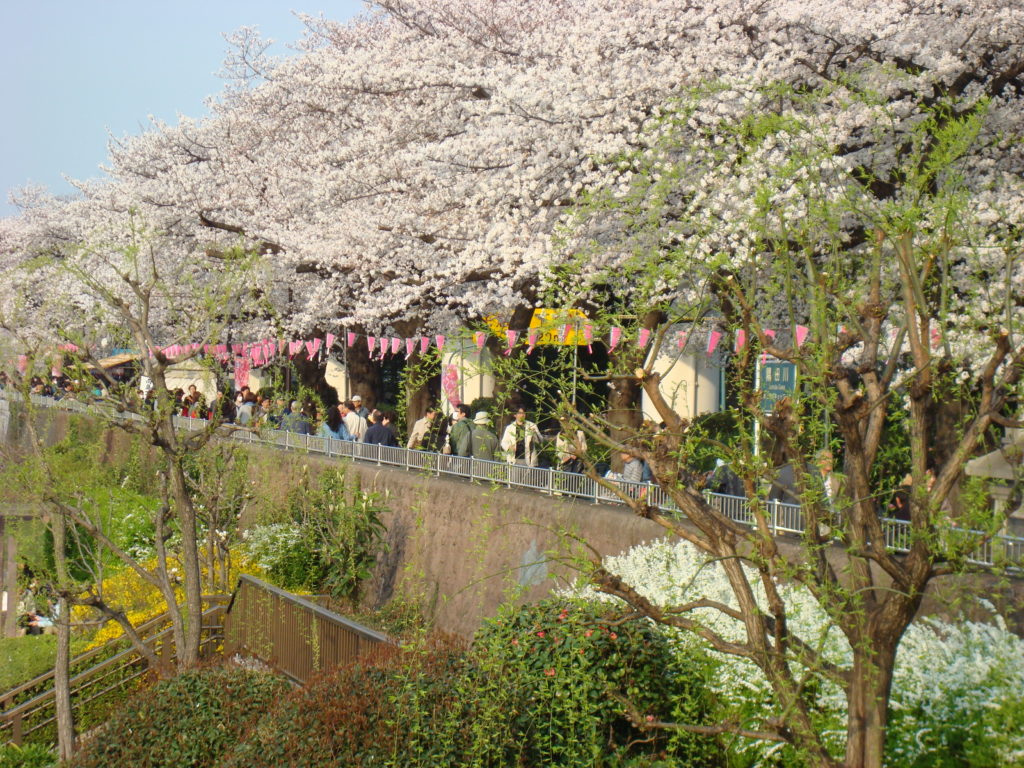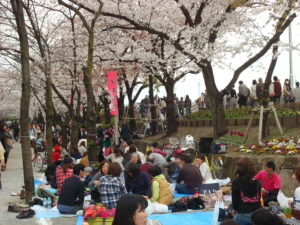Good morning and happy Easter!
Easter is the festival of the first full moon day after the spring equinox. Easter is Eoster,
which some scholars say is Uśas, Dawn, the Indo-European goddess. It is the time of
brightening and warming with the morning star and the dawning sun from the dark cold
night. It is the transition from windy winter to sunny spring. So, all over the world people
celebrate this time of the year in different names. Pesch(a) or Pesah is also from Uśas,
the Passover from slavery suffering to limitless liberation. It is the birth of new things
and the renewal from the old life. All kinds of flower start to bloom. So, we have flower
festivals. We talked about the spring equinox, which is identified as equanimity, nirvana,
the other shore. The Flower Festival is the Buddha’s birthday on April 8, a celebration
under the cherry blossoms, which is celebrated as Vesak in the southern tradition.
Already in Japan people are appreciating cherry blossoms with families and friends and
food and drink, participating in “hanami” (花見: flower viewing) – here hana (花:flower),
meaning cherry flowers. Cherry blossoms represent massive glorious blossoming and
also massive grandiose falling – immediate evanescence of life – in wind and rain, and
even without them, as if it is in their own nature. It shows naturalness, the natural flow
of phenomena in impermanence, which has become the Japanese sense of aesthetic
attitude and living way of “isagiyosa” (acceptance of the natural course and non-
attachment) or “akirame” (clarification and giving up) endowed with abundant natural
beauty together with brittleness, brevity, and the trainings and traditions of Buddhism
penetrating through their cultures.
Yesterday I watched an NHK TV program which featured the Cherry Festival in D.C.,
how the cherry trees were brought and how their blossoms have been appreciated for
more than a hundred years. In 1885 Eliza Scidmore, an international journalist, came
back from Japan and asked the U.S. Army Superintendents of the Office of Public
Buildings and Grounds to plant cherry trees along the Potomac River. She continued to
ask, in vain, for twenty four years, until in 1909 Helen Taft, the new first lady who had
lived in Japan and also appreciated cherry blossoms, agreed to the idea. On January 6,
two thousand cherry trees arrived in Washington, D.C. from Tokyo, as a token of
friendship from the Japanese people to American people. These trees were found to be
infested and diseased, so burned and destroyed. Soon, their goodwill determined to send
three thousand twenty trees, which arrived on March 26, 1912 and were planted.
Diana Parsell, an American writer, wanted to write a biography of Eliza Scidmore.
Because many of Scidmore’s records had been destroyed, Parsell visited Japan to
research her travels to archives, etc. While there she, too, appreciated cherry blossoms
and people’s blessings. She found that Scidmore had joined a club for growing morning
glories. Here, morning glories may seem simply weeds, but they are planted, potted, and
well-taken care of in Japan. Morning glories are like cherry blossoms, glowing in glory,
but very evanescent. In 1896 Scidmore reported on the Sanrikuoki-jishin, Offshore
Sanriku Earthquake, which was close to the one happened two years ago, letting the
word tsunami be known. She saw everyone enjoying cherry blossoms, all becoming
friends. She wanted to fill Potomac Park with cherry blossoms that would reflect on the
river with everyone, all, becoming friends.
Parsell visited Mukojima and found the people gathering as a century ago and, like
Scidmore, admired the Japanese people’s aesthetic views – becoming one with nature –
and wanted to bring them to America. This is not just appreciating flowers, but nature,
and all – all becoming friends together and becoming one with all. Other symbolism, like
the Buddha’s touching the ground, the Pope’s kissing the ground, washing and kissing
a traveler’s or troubled person’s feet, and prostration (gotaitōchi: 五体投地, throwing the
five parts of the body to the ground), is to become one with the great earth wherefrom
and whereto all life comes and goes back. Only when we become one with the whole
world, the total universe, do we become safe, secure, and satisfied totally. If we remain
separated, we must feel solitude, strife, and suffering. Only when we enjoy others’ joy
can we truly become happy, not seeing others and also ourselves in suffering.
When the Buddha was awakened in unconditioned peace and unsurpassed awakening,
he touched the ground and asked for its witness that it is ultimate reality and absolute
truth, which anyone can realize, and in which anyone can rejoice. It is realized in the
sitting that we do. Settling deep into the ground, sitting tall into the sky, is sīla.
Spreading branches wide into space, harmonizing with wind and water, the sun and
stars, is samādhi, harmony, oneness with all. Seeing far, wide, and deep enough is
prajñā, prognosis with penetrating insight far into the future, further species, and
farther worlds. So, this sitting is really to become one with the dharma dhātu,
universe, one world, penetrating perfectly. So, this is really the festival to celebrate
nirvana, unconditioned peace, and anuttara samyak sambodhi, unsupasssed right
complete awakening. Let’s enjoy our practice and this springtime and tide, when all
renew and recreate everything.
3/31/13
Note:
1. Diana Parsell happened to find Scidmore’s work and wanted to write her biography.
She found materials kept in Yokohama Archives of History and found the latter’s deep
understanding of the Japanese heart and her sincere wish to share it, with cherry
blossoms, in her work, Jinrikisha Days in Japan. Scidmore died in 1928, and her
remains were later brought to Japan by the Japanese government to appreciate the
contribution of her understanding and action, as shown by the epitaph on her grave
stone: The lady who loved cherry blossoms sleeps here.
Her blog: http://www.agreatblooming.com/
2. Cherry Blossom Festival in D.C.
History of the cherry trees:
A stretch of trees at Mukojima, where lanterns line the path for night viewing and crowds gravitate to outdoor stands offering fried noodles, grilled meat, sweets and cotton candy.
Picnicking and cherry tree viewing at Mukojima in Tokyo (Photos: D. Parsell)
(Photos from the above quoted blog site)


